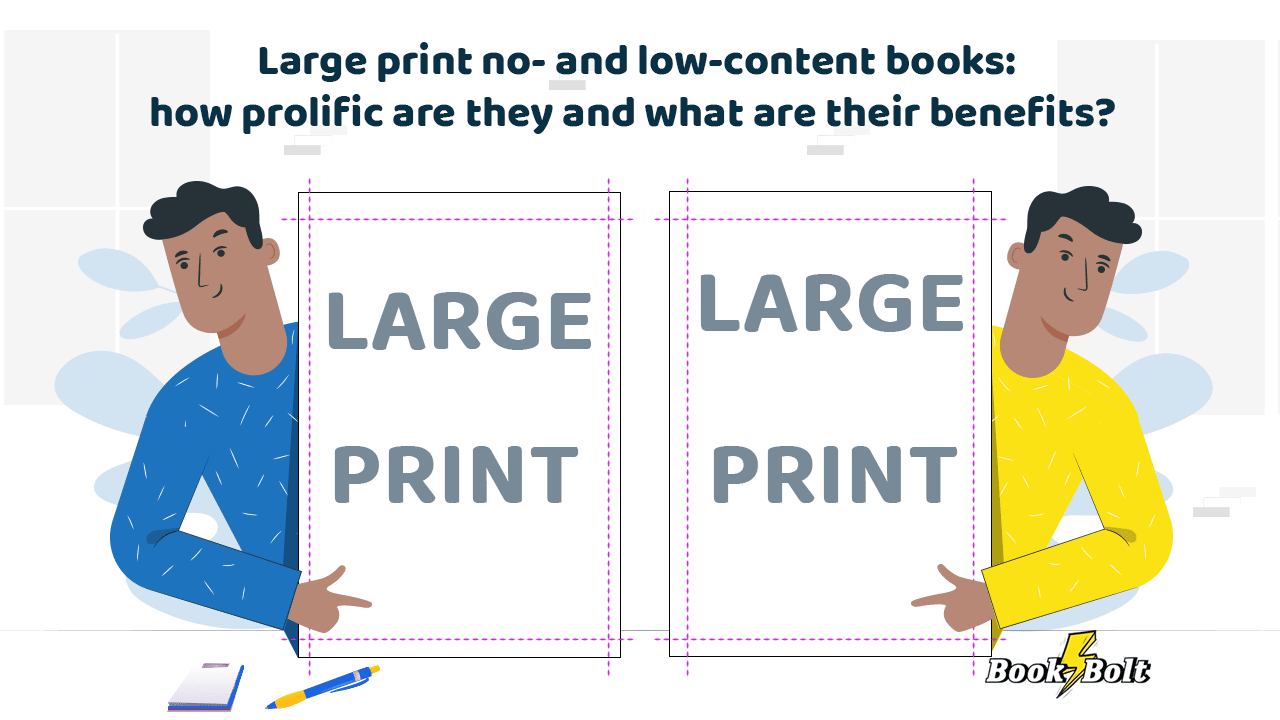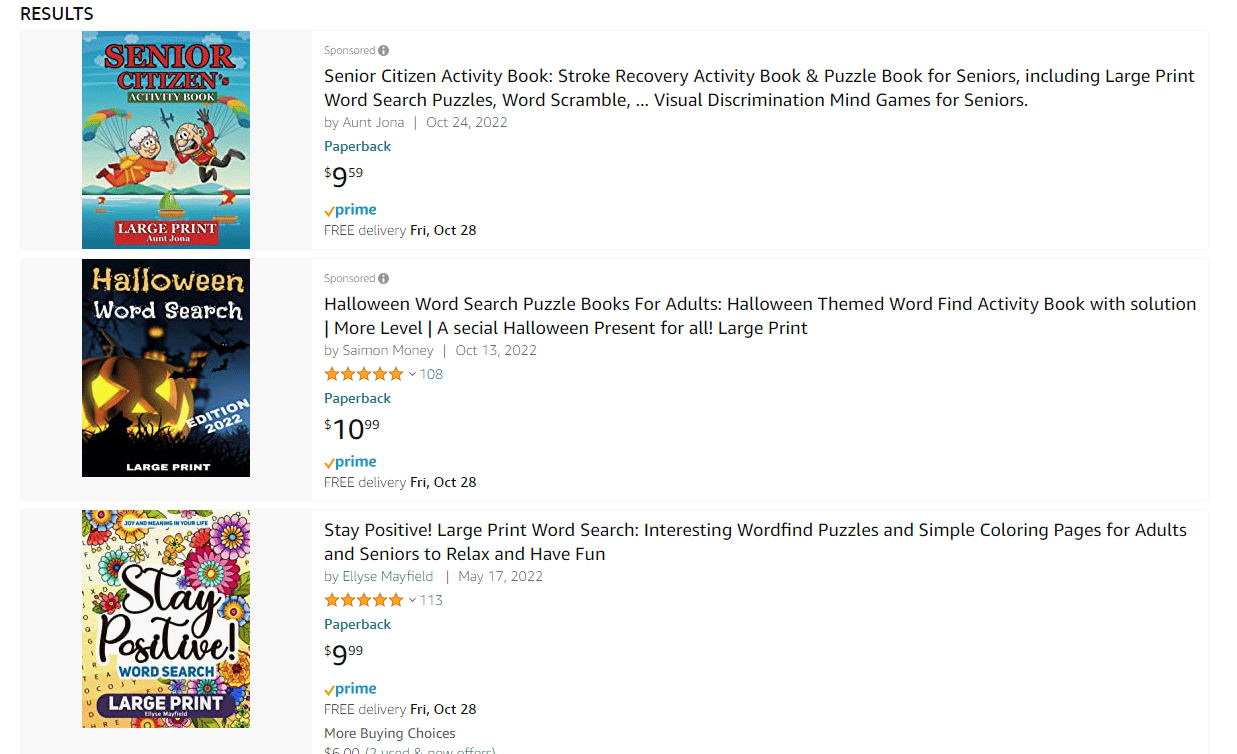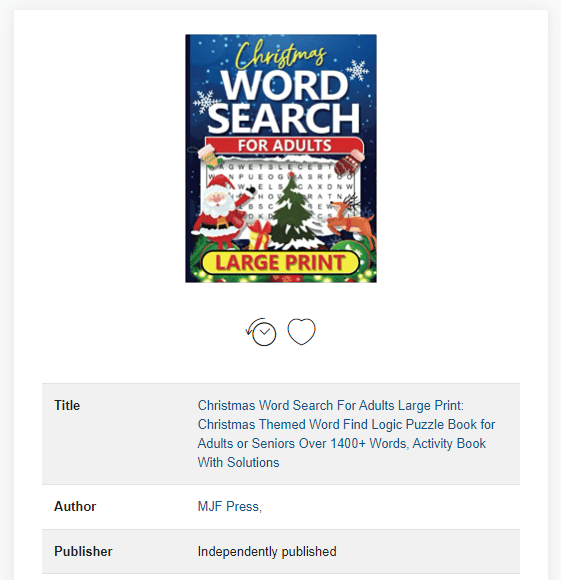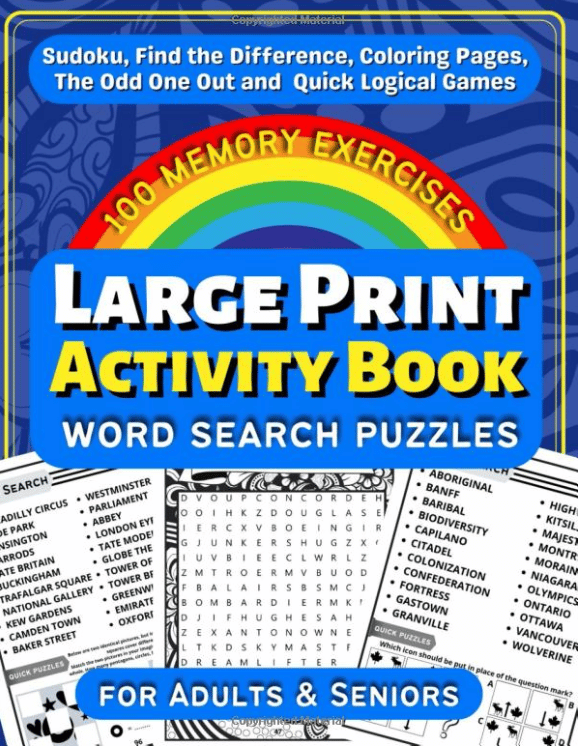
If your eyesight is pretty good, then you won’t have problems reading this. But there are many people – both children and seniors – who struggle with smaller fonts on books. Тhis is why large print no- and low-content books have entered the print-on-demand space. Some of the perks of large print books are that they can truly make reading much more enjoyable.
What’s more is that for children with dyslexia, for example, they can help promote literacy skills and improve comprehension. This is because of the lower strain that’s placed on the eyes when utilizing such books.
If large print is new to you as an Amazon KDP seller, then you may be surprised to find out that it is quite a profitable category in a wide variety of niches.
Here’s what else you need to know.
What is large print and who is it for?
As the name suggests, large print books are those no- and low-content books whose covers and interiors have a much wider font than the font sizes used in regular books. They are generally aimed at seniors although children who are visually impaired can benefit from these products just as much. In general, some eye conditions that could hinder reading small text include macular degeneration, cataracts, etc.
The American Council for the Blind recommends four particular features for better readability of large print books. These are the font size, font style, line spacing, and contrast. Regarding font size, the ideal would be anything in the region of 16 to 18, although some publishers have gone as high as 24.
It’s also important to note that large print books are not legally regulated in the United States. This means you have quite a lot of scope for creativity when it comes to creating your no- and low-content book cover.
How prolific are large print no- and low-content books?
We used Book Bolt’s “Cloud” module to take a look at how prolific the large print no- and low-content books are. A basic search query for activity books, for example, yielded 89 results with the top bestsellers. These bestsellers have priced their products as follows: lowest price ($3.58), highest price ($17.99), and average price ($814).
Interestingly enough, the best sellers rank (BSR) for this particular category of books is an impressive 214,205. This means that there’s not only demand for them but that many people are buying them.
A quick example to prove our point is the keyword phrase “large print word search puzzles for seniors”. It yields around 7,000 listings on Amazon.com. Although there are multiple search queries we can explore, this is a good indication to us that the market is vibrant, yet not overly saturated.
Who are some of the bestsellers in the large print book category?
Again using Book Bolt’s “Cloud” module, we were able to identify two of the top sellers in two particular categories: one for no-content and one for low-content books.
Notebooks
Independently published by author Elly Vell, we have “Address Book: Tabbed in Alphabetical Order, Large Print Notebook with Alphabetical Tabs 6″ x 9″, More than 300 Entry Spaces Addresses, Email, Work, Phone, Social Media, Birthdays”. This no-content notebook has 253 ratings and it was first published onto the Amazon market in December 2021. Since, then it has received an impressive 415 sales with a BSR of 8,439. The product is priced at $4.57.
Activity books
Another bestseller we came across is published by MJF Press. Their product is titled “Christmas Word Search For Adults Large Print: Christmas Themed Word Find Logic Puzzle Book for Adults or Seniors Over 1400+ Words, Activity Book With Solutions”. As a recent seller, coming onto the marketplace as recently as October 2022, this item has sold a whopping 474 times at a price of $6.99. Its BSR is 3,988.
How profitable are large print books?
In order to determine the profitability of large print books on Amazon.com, we took two bestselling listings positioned in the notebook and activity book categories. We also used the Amazon.com KDP royalty calculator to determine the sellers’ levels of profitability for these products.
Here’s what we found:
In the notebooks category, we turn again to author Elly Vell and the abovementioned bestseller. Aside from its exceptionally low BSR, the item has scored an estimated 415 monthly sales at a price of $4.57.
At 109 pages, this book yields royalties in the region of $0.59 per item. This, multiplied by 415 sales, gives us profitability of $244.85.
The second bestseller is also one we’ve discussed earlier, positioned in the activity books niche. It has sold approximately 474 times at a price of $6.99. Having done the calculations, we can conclude that this product yields royalties of $1.95 per book. Multiplying the royalties by the number of sales, we get $924.30 in profit per month.
Although the differences between the two sellers is quite drastic in terms of profit, the bottom line is that you can make in excess of a few hundred dollars by focusing on large print books. This can be your sole strategy or one that is combined in conjunction with other regular font sized books.
But what about the profitability of large print vs. regular print books? Does one fare better than the other? The answer is not as straightforward as we’d like it to be because factors that will need to be taken into account include the seasonality of the product (i.e. whether it’s for the Christmas holidays specifically), the category of book that is being offered (whether it’s no- or low-content), the niche it’s positioned in, and others.
Our overall recommendation is to avoid viewing large print books as golden ducks, but rather, to use them to diversify your portfolio.
Our advice to sellers regarding large print no- and low-content books
Based on our observations of large print books on Amazon KDP, we have determined some best practices that you can emulate.
Audience
As a starting point, you should always bear your audience in mind when creating large print books. Will you be selling to seniors or to children who struggle with their eyesight? These two categories of people are vastly different and have specific requirements.
As a result, it’s essential to ensure that your large print books do not cover everyone in the age spectrum, but that you rather focus on a single market segment at a time.
Listing optimization
You should also optimize your listings by ensuring that you use targeted and specific keywords in your titles and descriptions. In addition, the seven keyword slots when you upload your no- or low-content book manuscript should also be optimized.
This will mean including words like “large print” in titles, descriptions, and keyword slots. Also being specific about your audience such as “visually impaired”, “for seniors”, and others can help.
Cover and book design
Your cover design will be one of the most important attraction points for people who struggle to see well. This is why you should use an 18-point font size at the very minimum. Another strong recommendation is to use a sans serif font type. If you are creating notebooks or lined journals, ensure that you stick to a line height of 1.5 or higher. Avoid indenting your paragraphs, and rather space them.
Furthermore, it’s highly recommended that you do not use justified text and that you align your titles and headings to the left. If you use bulleted items, make sure these are double-spaced.
In addition to the above, you should try to keep your color scheme as simple as possible. Consider using only black text or ink in your interior where the nature of the book allows for it. Instead of italics (possibly in your title), consider using bold instead.
Finally, you’ll need to select a larger trim size for your book, too, when creating the final product.
Niches and product types
The final suggestion relates to niches and product types. As we already know, there are several categories of no- and low-content books on Amazon KDP. This means you have quite a wide selection to choose from.
However, if you’re targeting seniors, then an activity or puzzle book will be ideal. You can also target seniors with notebooks for helping them remember passwords and more. Journals with larger space for writing can also be a good option. The same is true for those sellers targeting children who prefer large print sized books.
In a nutshell
Although we may take our good eyesight for granted, some people really struggle with it. But that’s not to say that they should be excluded from the marketplace altogether. Instead, the more inclusive your portfolio of offerings is, the better for your sales efforts and the reputation of your business’ brand. Large print books are typically targeted at seniors although children who struggle to see can also benefit from these.
Hence, you already have a wide enough spectrum to work with. And if you’re already involved in creating low-content activity books, then you can simply readjust your covers and interiors to make dual use of your own efforts to sell more.
As a final point, we couldn’t have done our research without Book Bolt and its various modules. We highly recommend that you give it a try. It’s a small monthly investment of $9.99 that can really help skyrocket your Amazon KDP side business.



